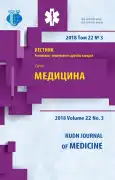HUMAN GRANULOCYTOTROPIC ANAPLASMOSIS
- Autores: Klimova YA1, Polovinkina NA1, Konnov VV1, Konnov DS1
-
Afiliações:
- Peoples Friendship University of Russia (RUDN University)
- Edição: Volume 22, Nº 3 (2018)
- Páginas: 322-331
- Seção: IMMUNOLOGY. INFECTIOUS PATHOLOGY
- URL: https://journal-vniispk.ru/2313-0245/article/view/345221
- DOI: https://doi.org/10.22363/2313-0245-2018-22-3-322-331
- ID: 345221
Citar
Texto integral
Resumo
Natural focal tick-borne infections are widespread in the world and are characterized by a great etiologic diversity. Human granulocytotropic anaplasmosis (HGA), also transmitted by the bite of ticks became relevant in the last century of detection not only in animals but also in humans. The review provides an overview of the incidence of HGA in Russia and in the world, the prevalence of the habitat of mites, the diversity of reservoirs and sources of infection, mechanisms and pathways of transmission of the pathogen Anaplasma phagocytophilum and its biological features. The links and stages of the disease pathogenesis are considered in detail. Scientific data on the clinical course of the disease, the frequency and diversity of various symptoms of the disease, the issues of laboratory and differential diagnosis of anaplasmosis and its place in the nosological structure in patients with fever of unknown origin are discussed. At the same time, choosing a method of laboratory diagnostics it is necessary to take into account that molecular-genetic method (polymerase chain reaction PCR-diagnosis) allows to confirm the diagnosis quickly, while serological methods of research in a greater degree - to put a retrospective diagnosis. The article presents current data on the treatment of disease and methods of HGA prevention and also presents the results of the authors’ own observations based on the survey of 63 patients. The analysis of Moscow residents treatment about sucking mites is carried out and summarized the incidence of infections transmitted by ixode mites. For the diagnosis of HGA and other tick-borne fever used a technique called polymerase chain reaction. It has been revealed that in Moscow, lime borreliosis occupies a leading place among mites associated with infections 60%, and the share of granulocytic anaplasmosis of a person is only 5% of patients. However, the study of ticks for the presence of HGA pathogens and other natural focal tick infections is carried out in insufficient volume (less than 30%), which should be considered in clinical and laboratory differential diagnosis, as well as preventive measures.
Palavras-chave
Sobre autores
Y Klimova
Peoples Friendship University of Russia (RUDN University)
Autor responsável pela correspondência
Email: klimova_yua@pfur.ru
N Polovinkina
Peoples Friendship University of Russia (RUDN University)
Email: klimova_yua@pfur.ru
V Konnov
Peoples Friendship University of Russia (RUDN University)
Email: klimova_yua@pfur.ru
D Konnov
Peoples Friendship University of Russia (RUDN University)
Email: klimova_yua@pfur.ru
Bibliografia
- Bakken J.S., Dumler S. Human granulocytic anaplasmosis. Infect Dis Clin North Am. 2015 Jun; 29(2): 341—355.
- Volosach O.S. Human granulocytic anaplasmosis. Journal of Grodno State Medical University. 2015. No. 2 (50): 151—154.
- Zhang L., Liu H., Xu B., Zhang Z., Jin Y., Li W., Lu Q., Li L., Chang L., Zhang X., Fan D., Cao M., Bao M., Zhang Y., Guan Z., Cheng X., Tian L., Wang S., Yu H., Yu Q., Wang Y., Zhang Y., Tang X., Yin J., Lao S., Wu B., Li J., Li W., Xu Q., Shi Y., Huang F. Rural residents in China are at increased risk of exposure to tick-borne pathogens Anaplasma phagocytophilum and Ehrlichia chaffeensis. Biomed Res Int. 2014;2014:313867. doi: 10.1155/2014/313867. Epub 2014 Apr 30
- Telford S.R. III, Korenberg Э.И., Goethert H.K. Detection of natural foci of babesiosis and granulocytic erlichiosis in Russia. Journal of Microbiology. 2002. № 6. P. 21—25.
- Rar V.A., Livanova N.N., Panov V.V., Doroschenko E.K., Pukhovskaya N.M., Vysochina N.P., Ivanov L.I. Genetic diversity of Anaplasma and Ehrlichia in the Asian part of Russia. Ticks and tick-borne diseases. 2010;1:57—65.
- The Federal Service for Supervision of Consumer Rights Protection and Human Welfare. Letter dated February, 26 2014 #01/2079-14-32. About the epidemiological situation on TBE and other infections transmitted by ticks in 2013 in the Russian Federation and the forecast for 2014.
- URL:https://www.uptodate.com/contents/human-ehrlichiosis-andanaplasmosis.
- Dugat T., Lagree A-C., Maillard R., Boulouis H-J. and Haddad N. (2015) Opening the black box of Anaplasma phagocytophilum diversity: current situation and future perspectives. Frontiers in Cellular and Infection Microbiology 5, 1—18.
- Centers for Disease Control and Prevention; 2008. [September 19, 2014]. Ehrlichiosis and anaplasmosis 2008 case definition. 2014 URL: https://wwwn.cdc.gov/ nndss/conditions/ehrlichiosis-and-anaplasmosis/case-definition/2008/.
- Blanco J.R., Oteo J.A. Human granulocytic ehrlichiosis in Europe. Clin Microbiol Infect 2002; 8:763.
- Afanaseva M.V. Clinical and epidemiological characteristics of granulocytic anaplasmosis in Russia. Abstract of dissertation of the сandidate of Medical Sciences. 14.00.10. Federal Budget Institute of Science “Central Research Institute for Epidemiology”. Moscow, 2006. 129.
- Rikihisa Y. Mechanisms of Obligatory Intracellular Infection with Anaplasma phagocytophilum. Curr. Microbiol. Rev. 2011. 24:469—489.
- Dumler J.S. The biological basis of severe outcomes in Anaplasma phagocytophilum infection. FEMS Immunol. Med. Microbiol. 2012. 64, 13—20.
- Pilar Alberdi, Pedro J. Espinosa, Alejandro Cabezas-Cruz, and José de la Fuente. Anaplasma phagocytophilum Manipulates Host Cell Apoptosis by Different Mechanisms to Establish Infection. Vet Sci. 2016 Sep; 3(3): 15.
- Hilary K. Truchan, David Seidman, and Jason A. Carlyon Breaking In and Grabbing A Meal: Anaplasma phagocytophilum Cellular Invasion, Nutrient Acquisition, and Promising Tools for Their Study. Microbes Infect. 2013 Dec; 15(0): 1017—1025.
- Rudakov N.V. Anaplasma and anaplasmosis. A guide for physicians. Omsk, 2017.
- Wormser G.P. Accuracy of Diagnosis of Human Granulocytic Anaplasmosis in China. Emerg Infect Dis. 2016 Oct; 22(10): 1728—1731.
- Teterin V.Y. Optimization of laboratory diagnostics and clinical features of Lyme disease and human granulocytic anaplasmosis. MD Theses. Federal Budget Institute of Science “Central Research Institute for Epidemiology”. Moscow, 2013. 23 p.
- Sanchez E., Vannier E., Wormser G.P., Hu L.T. Diagnosis, Treatment, and Prevention of Lyme Disease, Human Granulocytic Anaplasmosis, and Babesiosis: A Review. JAMA. 2016 Apr 26;315(16):1767—77.
- Kocan K.M., de la Fuente J., Cabezas-Cruz A. The genus Anaplasma: new challenges after reclassification. Rev Sci Tech. 2015 Aug;34(2):577—86.
Arquivos suplementares









